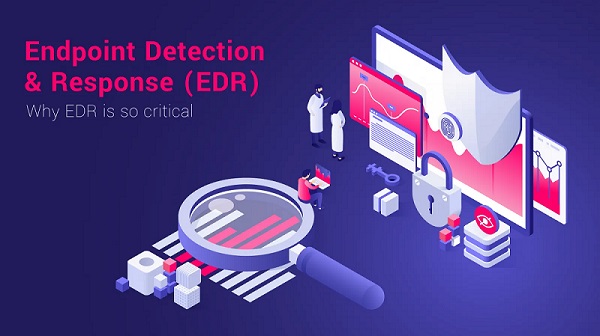Working Mechanism of EDR Endpoint Security Tools
Updated on July 11, 2023, by OpenEDR

Old antivirus tools and technologies do not hold the efficiency to protect against modern and advanced cybersecurity threats and malware. It requires something as updated and indispensable as the EDR endpoint security tool to safeguard a network against sophisticated and organized cybersecurity attacks. To fully understand the function and efficiency of the EDR endpoint security tool, we would first need to decode its working mechanism and get a thorough understanding of how it works to protect all the endpoints, like mobile, laptop, servers, etc., connected to a network.

So, let us move ahead and learn all the basic details about the EDR endpoint security tool, such as what EDR is, how it works, what its benefits are, and how an organization can use it as an advanced cybersecurity tool.
What are Endpoint Security Tools?
EDR endpoint security tool is an advanced cybersecurity tool that not only provides antivirus security to a network but also carries out continuous monitoring of all the endpoints connected to a network. It instantly detects any possible threats and malware that may sabotage the cybersecurity of an organization by continuous behavioral analysis. With continuous monitoring and detection, an EDR endpoint security tool safeguards essential and confidential documents and information from being misused or hacked by unethical hackers and cybercriminals. EDR endpoint guards all the possible endpoints or gateways through which malicious malware, spyware, ransomware, etc.
An updated and advanced EDR endpoint security tools such as OpenEDR® is capable of scanning even the most advanced and concealed threats that generally get overlooked by other antivirus programs and cybersecurity systems.
Working Mechanism of the EDR Endpoint Security Tool – How Does EDR Work?
A reliable EDR endpoint security tool like OpenEDR® performs multi-level functions to secure the endpoints of a network. These functions are directed towards monitoring, detecting, and analyzing every possible threat to remove the threat before it could reach and affect the other endpoints of the network. Through continuous surveillance and instantaneous actions, an EDR endpoint security tool confirms that the network is free from any irregular activities, threats, and encroachments.
Let us understand the working mechanism of the EDR endpoint security tool in a detailed and strategic manner.
The function of EDR can be understood in the categories and order mentioned below:
- Continuous and simultaneous monitoring of all endpoints.
An EDR endpoint security tool continuously monitors all the data that is present or is traveling through the endpoints connected to a network. Every egress and ingress data is thoroughly monitored and scanned by an EDR so that threats can be detected and removed instantly before they can travel further into the network and cause any significant damage.
- Identifying possible threats and malware.
Through continuous monitoring and behavioral analysis, the EDR endpoint security tool identifies the suspicious malware constricts it in its path, and gets it removed from the system and the network. This way, an EDR endpoint security tool also helps the cybersecurity team in tracing the path of the attacker.
- Automatic removal and remediation of threat.
When used in cohesion with other cybersecurity systems and tools, an EDR endpoint security tool instantly remedies and removes the threat or malware from the system and saves the organization from compromising or losing essential documents and information.
- Isolation of the affected or attacked endpoint.
To ensure the security of the network and all the other endpoints connected to the network, an EDR endpoint security tool takes a precautionary measure and isolates the affected system. This step eliminates the chances of the malware traveling further into the network and affecting other connected systems.
- Analyzing the threat as well as the attack.
The next step taken by an EDR endpoint security tool is to establish the security of the network and rule out the possibility of the occurrence of similar threats in the future. For this, the EDR endpoint security tool analyzes and investigates the IOCs or Indicators Of Compromise to save the system and the network from similar threats in futuristic prospects.
- Alerting the authorities and cybersecurity team.
After carrying out all the necessary operations from its side, an EDR endpoint security tool alerts the authorities and cybersecurity departments, which enables them to take action on an organizational level. The EDR endpoint security tools also helps the organization consolidate the affected systems and data for further investigation and analysis.
What are the Benefits of EDR Endpoint Security Tool?
EDR Benefits: An EDR endpoint security tool renders the following accountable cybersecurity benefits:
- Spontaneous, simultaneous, and continuous monitoring of the endpoints and systems.
- Full visibility of the network infrastructure, which enables it to monitor all the files transferred through every endpoint. It further helps in tracing the source and the path of every attack.
- The threat-hunting feature of an EDR endpoint security tool uses machine learning methods for the detection of known as well as unseen threats.
All in all, the EDR endpoint security tool offers numerous benefits over conventional antiviruses for intelligent and enhanced threat monitoring, detection, and removal from a network.
Conclusion – EDR Endpoint Security Tools
After unfolding the facts and information about the EDR endpoint security tool, we can conclude by saying that an EDR endpoint security tool has a strategic and advanced cybersecurity technology that makes it superior and more efficient than the other cybersecurity systems. Reliable and upfront EDR solutions like OpenEDR® regulate cybersecurity functions in a more comprehensive manner by using the latest machine learning as well as AI methods and technology.
See Also: